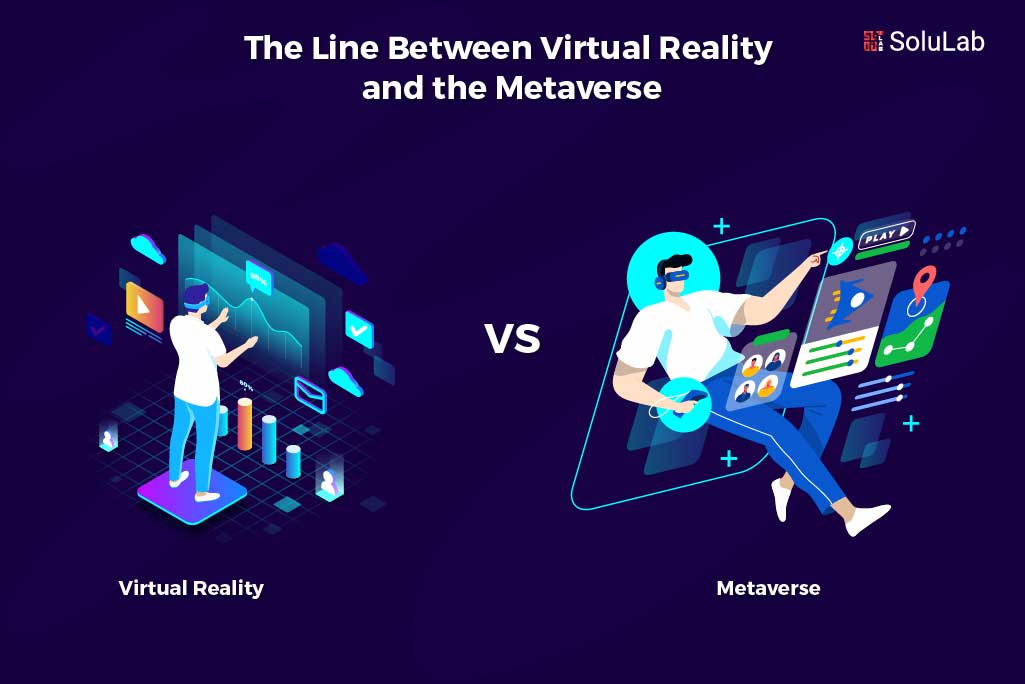
We have seen glimpses of virtual worlds in a number of works related to science fiction. The digital world’s concept is somewhat different from where one is able to escape from the real world. It is certainly an extremely exciting topic of discussion in the recent era of modern technology. We have readily come across the term Metaverse in the past few years. It has become a buzzword in recent times, and we get to hear a lot of development regarding the same. Another term that is rooted deeply in the Metaverse is virtual reality.
However, the association between Metaverse and virtual reality of VR has proved to be confusing many times. There are many who consider Metaverse to be virtual reality and use both the terms interchangeably. On the other hand, there are many who believe that Metaverse and virtual reality are different. In fact, it is a related concept. Virtual reality Metaverse is a broader concept which happens to be a combination of AR, VR, MR and XR.
Understanding the Metaverse Better
To understand the Metaverse better, it is of immense importance to understand all the underlying concepts. Let us analyze each of the associated concepts of the Metaverse briefly.
Virtual Reality
In technical terms, virtual reality of VR is any type of realistic simulation. It refers to a three-dimensional virtual environment generated by computers either to recreate a real environment or simply an imaginary world; Virtual reality is created by an appropriate blend of realistic images, sounds, and a number of other sensations via special devices such as VR or virtual reality headsets, gloves, helmets, and other body detectors that come with sense detectors.
Augmented Reality
Augmented reality or AR is a real-time view of any physical environment with its different elements through digital sensory input such as graphics, videos, sounds, or GPS data. To state it in other words, augmented reality exists over the physical world by empowering users to view the real environment with the help of the screens of mobiles, tablets, smart glasses, or similar types of devices that help make virtual changes to the environment on the screens of those devices. With the help of the integrated cameras of the devices, the augmented reality apps are able to surface digital content into the real environment.
Mixed Reality
Mixed reality or MR is many times referred to as hybrid reality. Mixed reality is the blending of two different worlds that is the virtual world and the physical world. The blending of these two worlds gives rise to an entirely new world where there are real-time interactions between virtual and physical objects. The mixed reality devices collect new information constantly that takes place in the surroundings. This type of information proves to be extremely helpful in placing digital content in the physical world in a smooth and uninterrupted manner to allow users to interact with the same. Mixed reality combines both physical and virtual worlds in a way that they are intertwined.
Extended Reality
Extended reality or XR is not quite a difficult concept. XR refers to the technology that has the ability to move between virtual reality and augmented reality or mixed reality. To state in simpler terms, XR happens to be a blend of VR and AR or MR.
Now, in a nutshell, Metaverse can be referred to as a combination of virtual reality and augmented reality or mixed reality within a shared as well as persistent virtual world.
The Need for VR and AR in the Metaverse
The concept of Metaverse has a very close relationship with the technologies of AI or artificial intelligence, AR or augmented reality, and VR or virtual reality. AR technology permits the implanting of virtual objects into the world that is real. On the other hand, virtual reality makes use of three-dimensional computer modeling, which happens to be one of the most engrossing types of graphic design, providing an immersive experience in a three-dimensional virtual world.
Metaverse does not necessarily need users to wear a virtual reality headset or any other similar types of accessories. However, experts seem to be quite confident that the technology of virtual reality is all set to become an integral part of the new Metaverse ecosystem. For instance, we can consider the Facebook Metaverse. Probably, it will be available via VR headsets, smart glasses with AR, and in a few ways in mobile apps and desktops. According to market research conducted by Statista, it is expected that the combined market of AR and VR will reach about 300 billion dollars by the year 2024.
The Line Between Virtual Reality and the Metaverse

One of the major challenges in grasping the concept of the Metaverse is the difference between the idea of VR and virtual reality. Reduced clarity among these two concepts give rise to a lot of doubts among the users. To state in a word, virtual reality might be a part of the Metaverse. However, Metaverse itself is a much broader term which combines different aspects of a number of digital areas, including augmented reality, virtual reality, social media, online gaming, and cryptocurrencies. Virtual reality can offer much realistic telepresence, which happens to be pretty different from the standard video conferencing that we know.
One of the major roles of the Metaverse is to bring about a transformation in the way content is consumed by us. It will be done by shifting it from two dimensions to three dimensions that are completely immersive and dynamic in nature. Since the Metaverse is a virtual space shared among all users, it is expected to transform the way of interaction between people and establish a connection between the virtual & real worlds. For instance, Metaverse can play a significant role in enhancing the communication level with a team working virtually in a remote environment. It also has the potential to modify ordinary video calls into realistic experiences, which induces a sense of the real presence of persons in the virtual meeting room.
Let us now briefly understand the line of differences on different terms between the Metaverse and virtual reality or VR.
Concept
- The Metaverse happens to be an open shared virtual environment with three-dimensional spaces that are virtual in nature. In the Metaverse, the users can explore and interact with content as well as other users as digital avatars of the virtual space.
- VR or virtual reality is the technology used for the purpose of creating three-dimensional spaces with sensory elements of sound, sight, and touch.
Ownership
- Speaking in terms of ownership, every user has full ownership of their belongings or assets as well as experiences when in the Metaverse.
- On the other hand, the brand owns the entire virtual reality system and all the related content.
Experiences
- In the Metaverse, each of the users is able to access a wide array of experiences.
- In virtual reality, every user has limited access to the virtual experiences provided by the virtual reality systems.
Technologies
- The Metaverse gets its support from different technologies such as virtual reality, augmented reality, mixed reality, extended reality, artificial intelligence, decentralization, and other connectivity technologies, along with facilitating fresh prospects for the purpose of integrating new technologies.
- Virtual reality is a finite or limited technology which maximum extends to providing simulated three-dimensional surroundings.
Persistence
- The Metaverse happens to be a shared as well as persistent virtual environment that continues to exist even when the users are not present in the Metaverse.
- The experience of virtual reality for the users stops instantaneously at the time when they switch off the devices they are using to experience virtual reality.
There are still a number of questions regarding the Metaverse, but we can consider it as something that is large-scale and multifunctional in nature. Most importantly, it is not limited to the experience of virtual reality and augmented reality, but the experience can be completely revealed at the time when these technologies are used.
The Metaverse has thus been very rightly compared to the internet’s next generation that is capable of providing a superior experience to the users, while virtual reality is a way to get in a much better manner. Therefore, it is absolutely clear virtual reality Metaverse is not just virtual reality but certainly a lot more than that.
Conclusion
After reading through the blog post, it is very clear that virtual reality Metaverse is not just virtual reality but a lot more than that. It is also true that virtual reality has a vital role to play in the Metaverse, and its importance cannot be neglected at any cost. The concept of Metaverse certainly looks quite exciting. However, it will certainly be a very tough task to predict the future of Metaverse at this point in time. It is true that Metaverse is booming at present with a huge inflow of investment by a number of tech giants all over the world.
In addition to this, we can also see that the rate of adoption of this technology is quite high among various businesses belonging to different industry verticals. It is very likely that the development of 5G, along with the expanding interest in virtual reality and augmented reality, can play a significant role in establishing favorable conditions for Metaverse in the time to come. So, we have to wait to see what the future has in store for the Metaverse.





